Brown Ladybugs (With Pictures) – Identification Guide
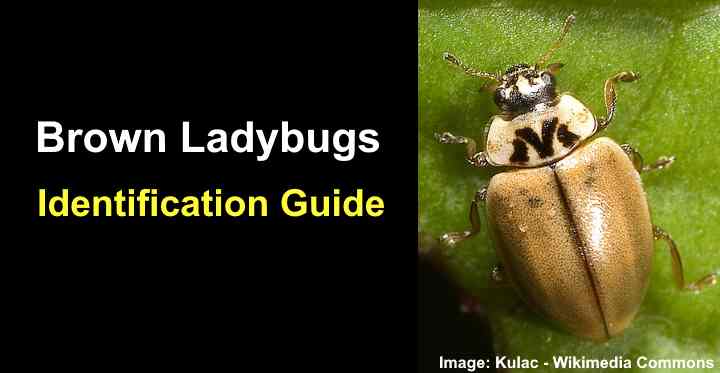
Brown ladybugs can be hard to spot because they tend to blend in with their surroundings. Ladybugs with brown wing cases camouflage well on plants, shrubs, and trees. Their tan, dark brown, chestnut, or mahogany colors make them difficult to spot on twigs and branches. Additionally, the creamy-colored markings on some brown ladybugs only add to their camouflage abilities.
Brown ladybugs with white spots are not as common as red and black varieties of ladybugs. Native ladybugs with brown coloring typically grow between 0.12” and 0.20” (3 – 5 mm). Therefore, their small size and brown patterns can make them tricky to find on plants.
One feature of brown ladybugs is that there can be tremendous variations in coloration and patterns. For example, the invasive Asian Lady Beetle (Harmonia axyridis) can be orange-brown with black spots on its wing cases. However, some variations of these flying beetles can be black ladybugs with red spots, orange beetles with no markings, or red and black—like traditional ladybugs.
In this article, we will discuss the various types of brown ladybugs. Descriptions and pictures of the brown “bugs” will help you recognize their identifiable features. Additionally, you will learn about types of beetles that look like brown ladybugs.
Why Are Some Ladybugs Brown?
Some ladybirds are brown to camouflage them from predators. Their brown elytra and whitish markings make the small beetles hard for birds and insects to identify on trees, shrubs, or the ground. This defense mechanism helps protect the brown ladybugs because they are not poisonous to other wildlife.
Brown ladybugs belong to the beetle family Coccinellidae. Identifying features of brown beetles are their domed elytra covering two pairs of wings, six legs, two antennae, and compound eyes. In addition, most brown ladybugs have various creamy-white or black markings on their wing covers.
Related Reading: Learn about ladybug’s life cycle.
Types of Brown Ladybugs (With Pictures and Descriptions)
Let’s look in more detail at the most common types of ladybugs with brown coloration.
Larch Ladybug (Aphidecta obliterata)
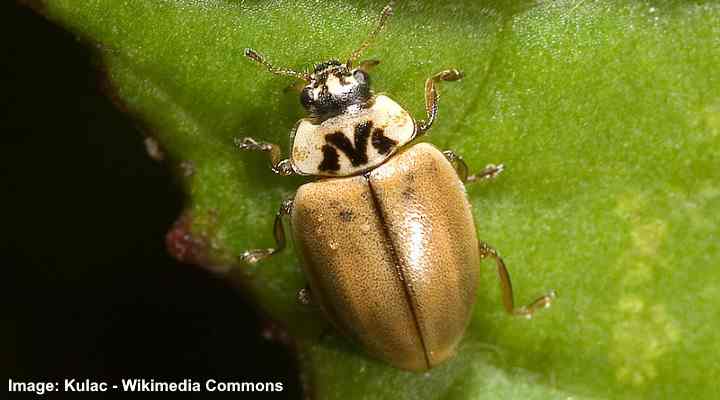
The light brown larch ladybug is common in North America and can be identified by its distinctive M mark on its pronotum
The larch ladybug is one of the most common brown ladybugs you will find on plants in North America. The identifying features of the oval insects are tan to brown elytra, a distinctive M mark on its pronotum, and a black head. The brown ladybugs measure 0.14” to 0.20” (3.5 – 5 mm).
A black stripe down the back makes the oval brown beetle look like a lightly roasted coffee bean. Another notable feature is its lack of distinctive black or white markings on its back.
Brown larch ladybugs are typically found on pine, spruce, and larch trees. Like most ladybirds, the small, winged creatures feed on aphids during spring and summer, when they are most active.
Identifying larch ladybugs can be challenging because of variations in the species. For example, the dark brown form has almost black elytra. However, the tan color form is a more orangey-brown color. And there is a yellow form of larch ladybugs with a black stripe down its back.
Asian Lady Beetle (Harmonia axyridis)
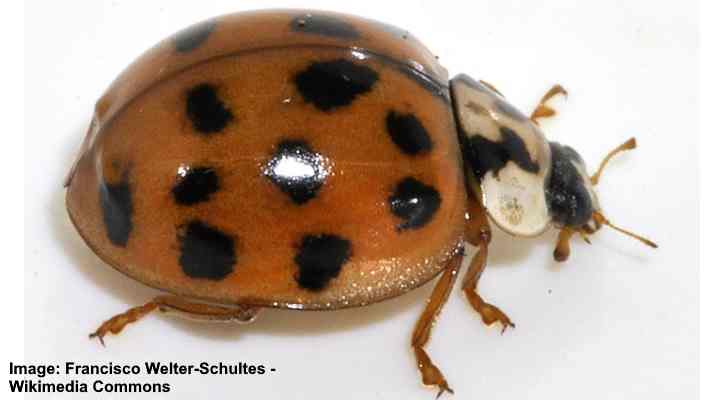
The Asian lady beetle has orange-brown body with black spots but can have color variations
One of the most annoying brown ladybugs is the Asian lady beetle. This invasive flying insect can have orange-brown elytra with several large spots. The large brown ladybugs can measure 0.21” to 0.33” (5.5 – 8.5 mm) in size. The non-native beetles are widespread throughout North America and threaten native red and black ladybugs.
Also called the Halloween beetle, the reddish-brown bug can invade homes in late fall. Other names for the pesky insects are harlequin ladybug or multi-colored Asian beetle. Unlike many other types of insects, these ladybugs overwinter in warm places until they become active in springtime.
Painted Ladybug (Mulsantina picta)

The painted ladybug is identified by its mottled brown and gray patterns and black and white pronotum
The painted ladybug is a common brown beetle with brown and grayish mottled patterns on its elytra. Characteristics of the patchy brown ladybug are its brown legs, black and white pronotum, and pair of antennae. This tiny brown flying beetle measures 0.09” to 0.15” (2.2 – 4 mm).
Also called pine ladybeetles, the small brown ladybugs are found in pine forests, feeding on aphids and adelgids.
Like many species of ladybugs, the painted lady beetle has several color variations. Some can be orange and black, red and black, or pinkish-pale brown with dark brown markings.
Rhyzobius chrysomeloides
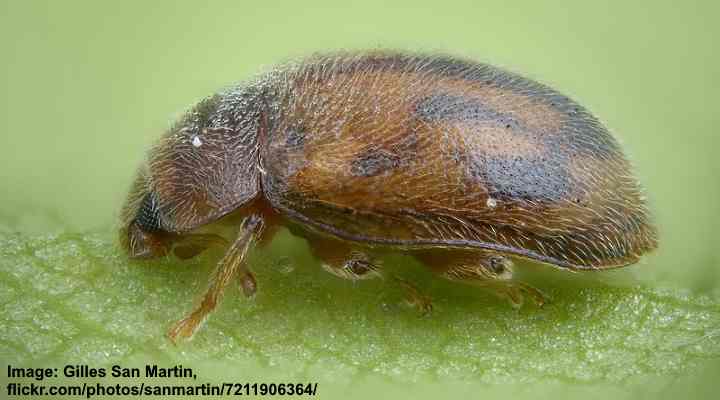
You can recognize Rhyzobius chrysomeloides ladybug by its brown and black patterned body that is covered in fine hairs
Rhyzobius chrysomeloides is an unusual brown ladybug with dark brown and black elytra covered in fine hairs. The fuzzy brown ladybugs have six legs, two straight antennae, and an oval shape. The head and pronotum have black and brown markings similar to the hairy wing covers.
Rhyzobius chrysomeloides measures 0.09″ to 0.14″ (2.3 – 3.5 mm) in size. The dark brown or black patterns on the elytra vary but are common in most ladybugs in the genus. The small brown bugs are found on coniferous and deciduous trees, especially if ivy is growing nearby.
Eye-Spotted Ladybug (Anatis mali)
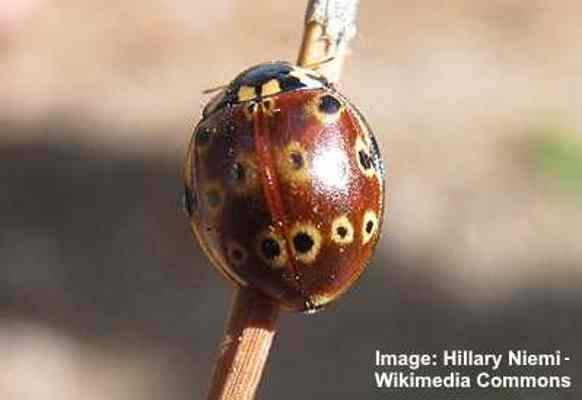
The eye-spotted lady beetle can be easily identified by its black and beige spots on its reddish-brown body
The eye-spotted ladybug has reddish-brown elytra covered in distinctive eye-like markings. The spots on the shiny brown wing cases are black dots surrounded by a creamy-white ring. In addition, most species have a black pronotum with white markings at the sides and base. These large brown ladybugs measure 0.28” to 0.39” (7.3 – 10 mm) in length.
The reddish-brown ladybugs have eight eye spots on each elytron, giving the ladybug 16 in total. This feature sets it apart from the brown form of the fifteen-spot ladybug (Anatis labiculata). This is a common brown ladybug with 15 black spots on its wing covers.
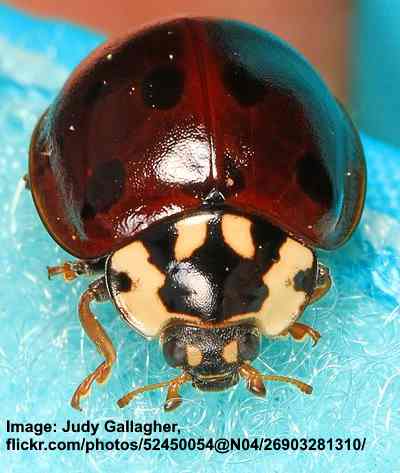
Fifteen-spot ladybug (Anatis labiculata)
Eye-spotted ladybugs commonly reside in tree canopies, especially in conifer forests. They feed on aphids when they are active from late April through October.
Three-Striped Ladybug (Brumoides suturalis)
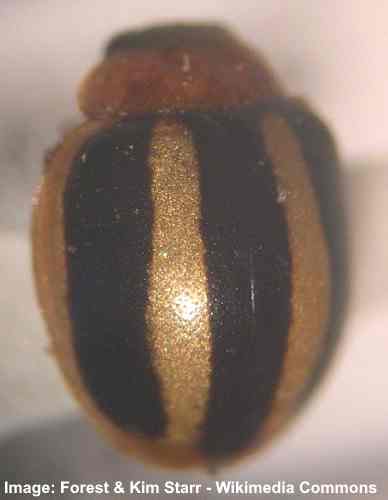
The three-striped ladybug has black and brown stripes on its wing covers
The three-striped ladybug is an eye-catching ladybug with golden-brown stripes on a black body. The ladybug’s head, thorax, and legs are brown. Other color variations of the striped ladybug are black and white stripes with a pale brown head and thorax. The small brown ladybug measures 0.08” to 0.14” (2.0 – 3.5 mm).
Vibidia duodecimguttata
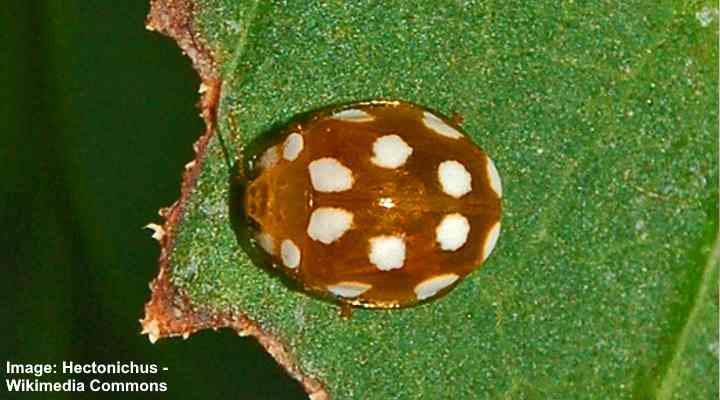
The white spotted brown Vibidia duodecimguttata feeds on powdery mildew unlike other ladybugs
The Vibidia duodecimguttata flying beetle is a pale brown ladybug with vibrant white spots on its domed elytra. The brown ladybug has an oval body, six pairs of white spots, and light brown legs. Other prominent identifying features are its black eyes and two white spots on the side of its head.
Vibidia duodecimguttata brown ladybugs measure 0.16” (4 mm) in length. Unlike other predatory ladybugs, this white-spotted brown beetle feeds on powdery mildew fungus, not other insects. You will find the small ladybug active from April through September.
The ladybug’s scientific name refers to the 12 spots on its back.
Cream-Spot Ladybug (Calvia quattuordecimguttata)
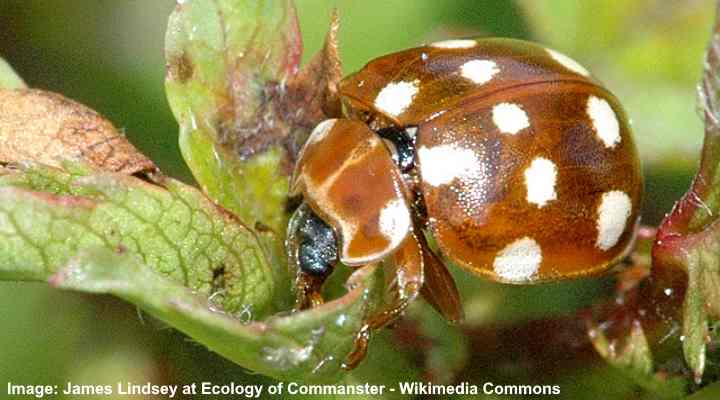
The cream-spot ladybug has a brown body with white spots and a black head
The cream-spot ladybug is a walnut-brown winged insect with 14 white spots on its wing cases. The medium-sized brown ladybug is found throughout North America. Identifying features of the beetle are reddish-brown color, white dots on its back, a white spot on either side of its thorax, and a black head.
The cream-spot ladybug measures 0.16” to 0.20” (4 – 5 mm) in length. Due to its spotted appearance, the brown ladybug also goes by the names polka dot lady beetle or 18-spot ladybird. This non-native ladybug is found in mixed-leaf forests, parks, grasses, and meadows. Like most brown ladybugs, its main diet is aphids and psyllids.
All ladybugs have larvae that look like tiny alligators, and the cream-spot ladybug is no exception. After hatching from eggs, black larvae appear. They have white markings and rows of blunt, fleshy spines along their backs.
Heather Ladybug (Chilocorus bipustulatus)
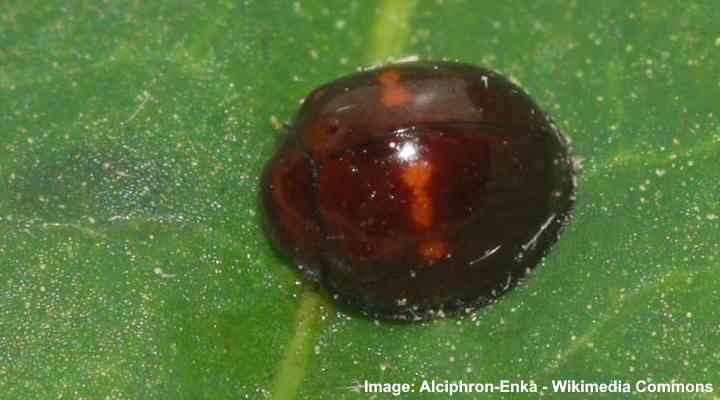
The heather ladybug can be identified by its red spots in a row on a dark brown shiny body
The heather ladybug is a dark brown beetle species with glossy elytra and two reddish-orange spots on them. The small dark brown to black ladybug measures 0.12” to 0.20” (3 – 5 mm) long. On some species, the elytra have three tiny red spots forming a horizontal line when viewed from above.
A distinctive feature of this shiny brown ladybug is its domed wing covers with a pronounced rim around the edges. The ladybug’s head, feet, underside, and tiny antennae are all black. Although the species is classified as a glossy dark brown ladybug, some look almost black with four or six red spots.
Eighteen-Spot ladybug (Myrrha octodecimguttata)
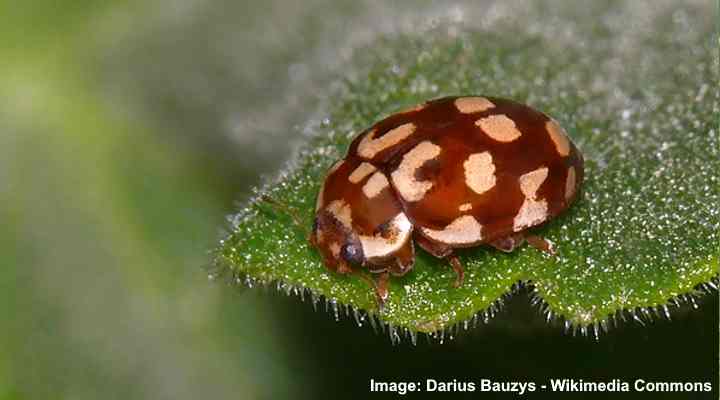
The eighteen-spot ladybug has white patches on its elongated brown body
The eighteen-spot ladybug is a striking orange-brown or maroon-brown ladybug with creamy white patches on its back. The identifying features of the light brown ladybug are its elongated oval shape, irregular whitish spots, brown legs, and black compound eyes. The medium-sized beetle measures 0.16” to 0.20” (4 – 5 mm) long.
The nine pairs of white spots are the main identifying feature of the brown ladybug. The ladybugs are active from late spring through fall and inhabit the canopies of coniferous and deciduous forests. Typical of brown ladybugs, they feed on aphids and other soft-bodied pests.
The carrot-shaped larvae of the eighteen-spotted ladybug are pale gray with black tubercles. Additionally, the small crawling insects have yellow or bright orange markings on their abdominal segments.
Striped Ladybug (Myzia oblongoguttata)
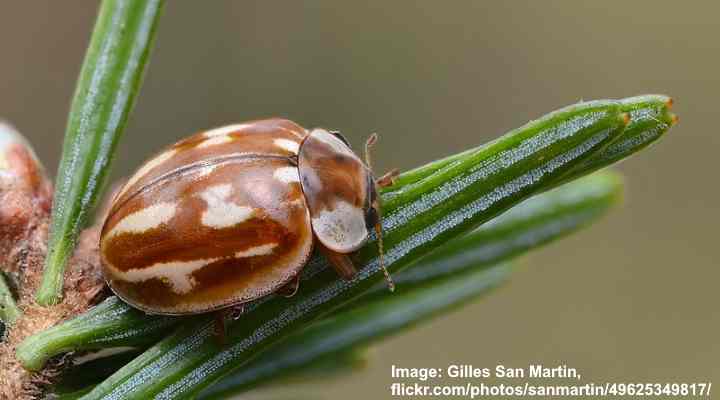
The striped ladybug has white patches on its brown body, as well as two large white spots on its thorax
The striped ladybug is a species of brown ladybug commonly found on pine, spruce, and beech trees. The chestnut-colored ladybugs have creamy-white spots and stripes on their elytra, large white patches on their brown thorax, and a black head. The white-striped brown ladybug measures 0.23” to 0.31” (6 to 8 mm) long.
As beneficial insects, striped ladybirds help reduce populations of aphids. After being active from spring through late summer, the brown ladybugs overwinter in tree crevices and organic debris on the forest floor.
Mealybug Ladybug (Cryptolaemus montrouzieri)
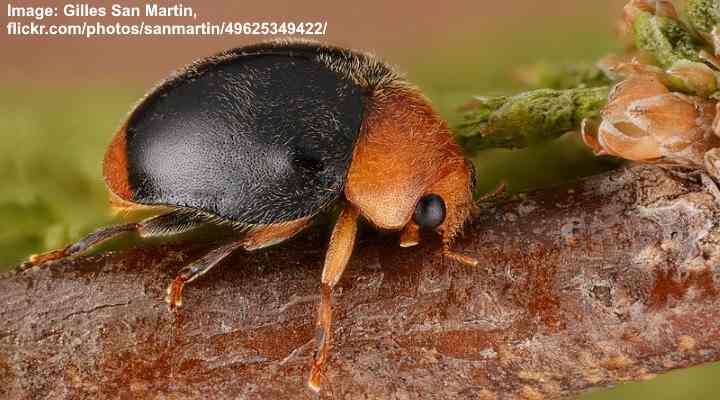
The mealybug ladybug has black or dark brown body covered in fine hairs and orange-brown front and rear ends
The mealybug ladybird, also known as the mealybug destroyer, is a type of dark brown, sometimes black, ladybird with a brightly-colored orange-brown head. This unusual brown ladybug is covered in fine hairs (setae), giving it a silvery appearance. In addition, the ladybug’s antennae, legs, and pronotum are orangey-brown.
These little hairy brown ladybugs grow 0.16” to 0.23” (4 – 6 mm) long. One of the characteristics of Cryptolaemus montrouzieri is that the larvae and adult insects feed on mealybugs and scale insects. Interestingly, the larvae look like fluffy white mealybugs as a type of aggressive mimicry.
Unlike most other brown ladybugs on the list, mealybug ladybirds don’t have any spots or discernable markings on their elytra.
Two-Spotted Ladybug (Adalia bipunctata)
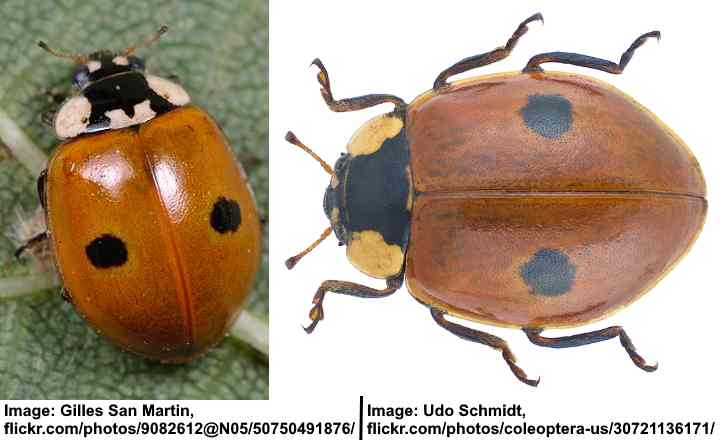
The two-spotted ladybug has reddish-brown body with two black spots, however coloration and patterns vary
This reddish-brown species of lady beetle, the two-spotted ladybug, is called so due to the two black spots on its back. One of the striking features of this type of lady beetle is the 2 large white spots on the pronotum. This makes the beetle look like it has 2 large eyes.
However, there are color variations among the species of Adalia bipunctata, and some are known to have more than just two spots.
The two-spotted ladybug is popular in Europe and North America to help control crop pests.
Mexican Bean Beetle (Epilachna varivestis)
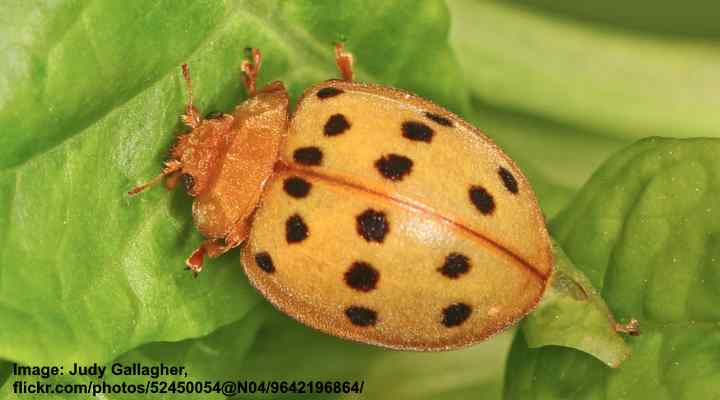
The Mexican bean beetle is a type of orange or pale brown lady beetle that cause damage to the leaves of legume crops
The Mexican bean beetle is an oval brown or orange beetle that damages crops in America. The destructive beetles can be rusty brown or golden yellow and have several black dots on their elytra. The brownish flying beetles grow 0.23” to 0.27” (6 – 7 mm) long.
Mexican bean beetles are classified as true ladybugs because they are in the family Coccinellidae. However, unlike their beneficial counterparts, the bugs don’t feed on other insects. Instead, the larvae and adults feed on flowers, leaves, and plant tissue of beans and other legumes.
These beetles can cause significant damage to bean crops, so it’s important to take preventative measures if you spot them. Some of the most effective methods for controlling Mexican bean beetles include planting certain trap crops and introducing natural predators such as ladybugs or lacewings. Although labor intensive, hand-picking is one of the most effective ways of eradicating Mexican bean beetles.
Brown Beetles that Look Like Ladybugs
Although ladybugs are in the beetle order Coleoptera, not all flying beetles are ladybugs. However, there are several types of brown beetles with domed wing covers and distinctive markings, making them easy to mistake for brown ladybugs.
It’s good to note that many people say that the Asian lady beetle is a ladybug look-alike. However, Asian ladybeetles are also in the family Coccinellidae, making them true ladybugs. The only difference is that the Asian ladybugs are invasive and more aggressive than native North American ladybugs.
Here are some types of beetles that differ from most ladybugs because they are not beneficial insects.
Colorado Potato Beetle (Leptinotarsa decemlineata)
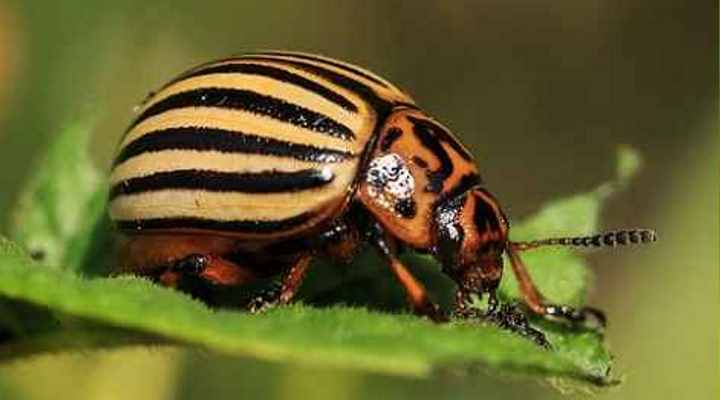
The Colorado potato beetle is identified by its orange head and black markings as well as beige-light brown striped body
The Colorado potato beetle has a distinctive pale brown-beige striped oval, rounded body. Also called the ten-lined potato beetle, the highly destructive insect measures 0.24” to 0.43” (6 – 11 mm) long. The orange-light brown bugs are recognized by their five bold black stripes on each wing cover.
Colorado potato beetle damage on potato crops can be extensive. The striped, orange-pale brown bugs can defoliate potato plants and cause destruction to tomato leaves and eggplant crops. In some cases, a large infestation can destroy an entire crop.
Brown Carpet Beetle (Attagenus smirnovi)
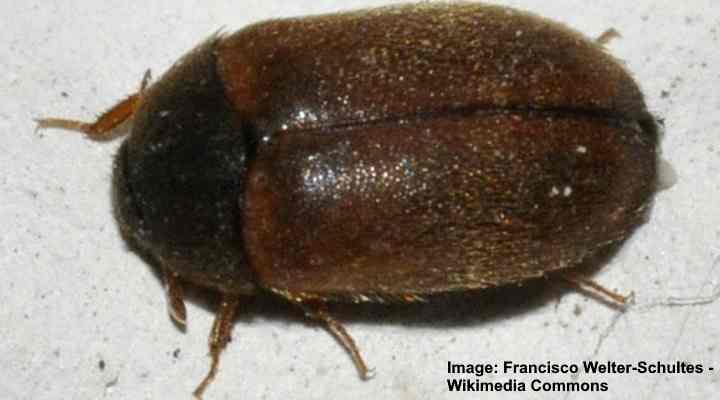
The brown carpet beetle can infest homes feeding on fabrics and carpets
Brown carpet beetles are a species of small brown beetle that can be found in many homes across North America. These beetles measure 0.09” to 0.15” (2.3 – 4 mm) in length. The beetles look like ladybugs because they have an oval-shaped body, light or dark brown elytra, and dark brown to black pronotum.
Brown ladybug look-alikes—carpet beetles—feed on materials such as carpets, fabrics, and furs. Damage caused by carpet beetles includes holes in carpets, upholstery, and clothing. To prevent infestations, it’s important to keep your home clean and vacuum regularly.
How to Get Rid of Brown Ladybugs
Getting rid of brown ladybugs is crucial when dealing with Asian ladybeetles (Harmonia axyridis) or Mexican bean beetles (Epilachna varivestis).
Asian ladybugs can be beneficial insects when they feed on thousands of aphids in summer. However, the irritating bugs will try to venture indoors in October when the temperature drops. Although they typically don’t bite or spread disease, the ladybugs excrete a foul-smelling yellowish liquid that can stain fabrics.
The best way to get rid of brown ladybugs from your home is to seal all cracks and crevices in late summer. Additionally, you could install window screens to stop pesky bugs from flying in through open windows.
What should you do if you find brown ladybugs indoors? The best way to eradicate them is to use a vacuum cleaner. This method avoids squashing the bugs, which can cause a stench and result in staining.
How can you get rid of Mexican bean beetles from your yard? If the nasty brown critters are a nuisance in your area, consider planting early-maturing bean varieties. Then during late spring and summer, check the undersides of plant leaves regularly for signs of eggs, larvae, or adult beetles. The most effective eradication method is to hand-pick them and drop them into a bucket of soapy water.
Related articles:
